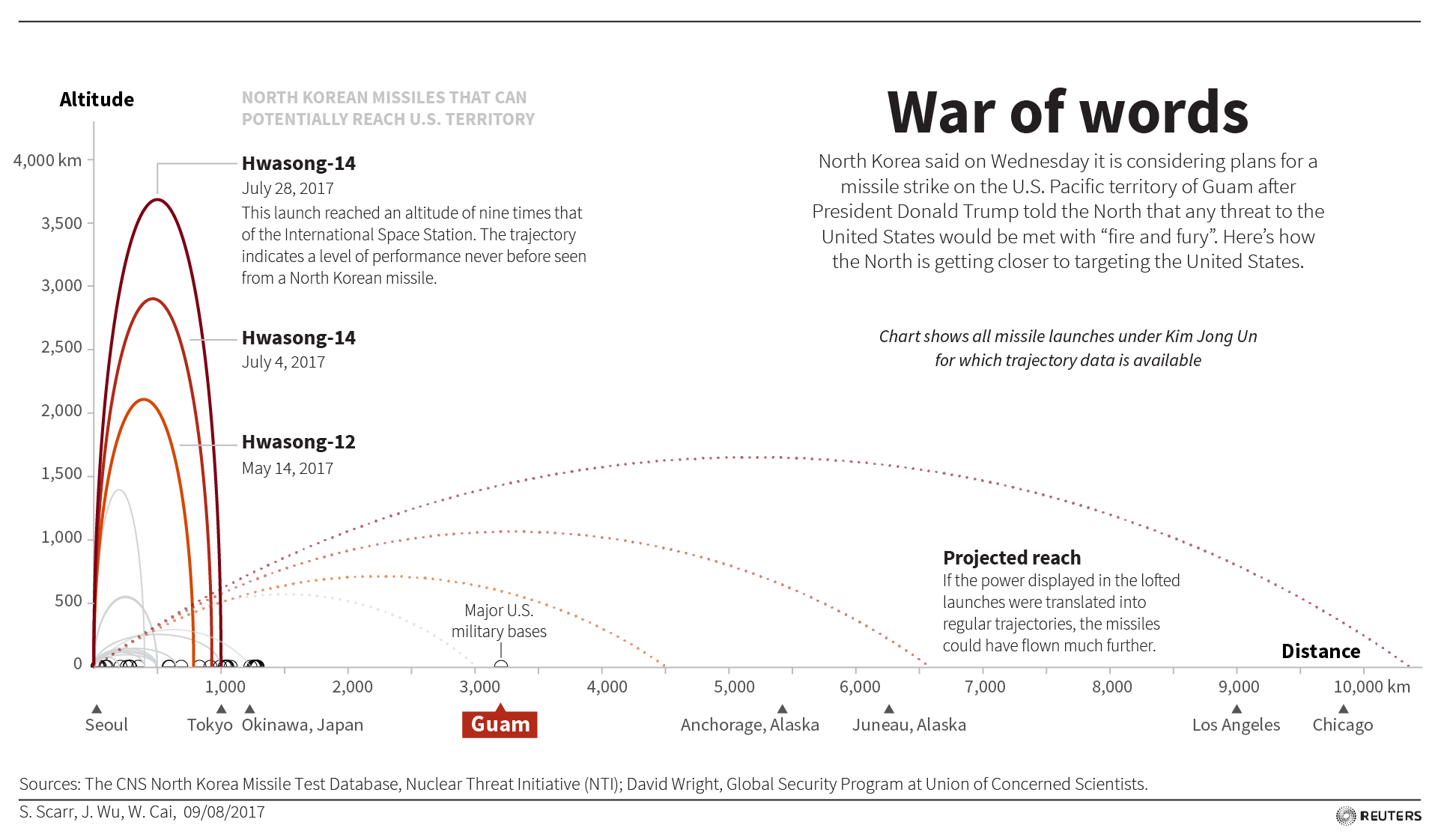
By Ben Blanchard and Tim Kelly
BEIJING/TOKYO (Reuters) – U.S. President Donald Trump on Wednesday praised North Korean leader Kim Jong Un for a “wise” decision not to fire missiles towards the U.S. territory of Guam and for easing escalating tension between the two countries.
Reclusive North Korea has made no secret of its plan to develop a missile capable of firing a nuclear warhead at the United States to counter what it perceives as constant U.S. threats of invasion, and tension has been rising for months.
Trump warned North Korea last week it would face “fire and fury” if it threatened the United States, prompting North Korea to say it was considering test-firing missiles towards the Pacific island of Guam.
But North Korean media reported on Tuesday Kim had delayed the decision while he awaited to see what the United States did next.
“Kim Jong Un of North Korea made a very wise and well reasoned decision,” Trump wrote on Twitter.
“The alternative would have been both catastrophic and unacceptable!”
North Korea has long ignored warnings from the West and from its lone major ally, China, to halt its nuclear and missile tests which it conducts in defiance of U.N. Security Council resolutions.
The United States has been hoping China can press the North to rein in its weapons programmes. The top U.S. general reiterated that in talks in Beijing this week.
Chairman of the U.S. Joint Chiefs of Staff Joseph Dunford told Fang Fenghui, chief of the Joint Staff Department of the People’s Liberation Army, in Beijing that North Korea’s weapons programmes threatened the entire international community, including China.
“He emphasised that the U.S. and China have the same goal – a denuclearised Korean peninsula achieved through peaceful means … North Korean actions threaten the economic and military security of China,” a U.S. military spokesman said in a statement.
“In the interest of regional stability, he said the U.S. views with growing urgency the need for China to increase pressure on the North Korean regime,” the spokesman said.
“Should preferred diplomatic and economic peaceful options fail, General Dunford reiterated America’s resolve to use the full range of military capabilities to defend our allies in the Republic of Korea and Japan, as well as the U.S. homeland.”
‘SOLIDARITY AND RESOLVE’
China has repeatedly called for all sides to exercise restraint and remain calm, and while it has signed up for tough U.N. sanctions on North Korea, it says the key to a resolution lies in Washington and Pyongyang talking to each other, rather than expecting China to do all the work.
Japan conducted air manoeuvres with U.S. bombers southwest of the Korean peninsula on Wednesday involving two U.S. Air Force B-1B Lancer bombers flying from Andersen Air Force Base on Guam and two Japanese F-15 jet fighters, Japan’s Air Self Defence Force said in a news release.
“These training flights with Japan demonstrate the solidarity and resolve we share with our allies to preserve peace and security in the Indo-Asia-Pacific,” the U.S. Air Force said.
The U.S. aircraft have flown several sorties in East Asia over recent weeks. In addition to air drills with Japanese fighters, the bombers have also exercised with South Korean aircraft.
North Korea regards the U.S. exercises with South Korea and Japan as preparations for invasion. The exercises also upset China, which says they do nothing to ease tension.
On Wednesday, a senior Chinese military officer reiterated China’s position on the need to maintain peace and stability to Dunford, China’s Defence Ministry said.
Song Puxuan, commander of China’s Northern Theatre Command, stressed to Dunford that the North Korean nuclear issue must be resolved politically through talks, the ministry added.
The command is based in China’s northeastern city of Shenyang and has responsibility for a swath of northern China, including the border with North Korea.
North Korea’s threat to fire towards Guam had prompted U.S. Trump to say the U.S. military was “locked and loaded” if North Korea acted unwisely.
‘RECKLESS ACTIONS’
In his first public appearance in about two weeks, Kim on Monday inspected the command of North Korea’s army, examining the plan to fire four missiles aimed at landing near Guam, the official KCNA news agency reported.
“He said that if the Yankees persist in their extremely dangerous reckless actions on the Korean peninsula and in its vicinity, testing the self-restraint of the DPRK, the latter will make an important decision as it already declared,” KCNA said.
DPRK stands for the Democratic People’s Republic of Korea, North Korea’s official name.
Wednesday’s air exercise took place close to Japanese-controlled islets in the East China Sea which are also claimed by China. The uninhabited territory is known as Senkaku in Japan and Diaoyu in China.
While the United States has declined to take sides in the dispute over the tiny islands, it nonetheless has said it would defend them from attack under its security alliance with Japan.
Chinese Foreign Minister Wang Yi, in a telephone conversation with Sigmar Gabriel, Germany’s minister for foreign affairs, said tension on the Korean peninsula was showing some signs of easing but had not passed.
The parties involved should “make a correct judgment and wise choice by taking a responsible attitude toward history and people”, Wang said, according to a statement on his ministry’s website.
(Additional reporting by Nobuhiro Kubo, and Ben Blanchard in BEIJING; Editing by Nick Macfie, Robert Birsel)







